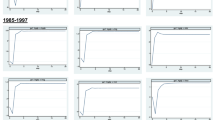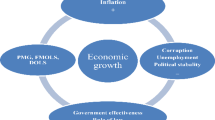Abstract
This paper investigates the influence of economic institutions in the debt-growth nexus. Using data from 1970 to 2020 on Nigeria, the paper extends the econometric literature by deploying cointegration techniques that account for structural breaks. A long equilibrium relationship was found among debt, growth, economic institutions and associated variables. The effect of debt on growth was found to be positive up to a threshold of 13.62% and 27.19% of gross domestic product in the short and long-run respectively, beyond which its effect becomes negative and significant. Growth is more sensitive to economic institutions than debt, underscoring the criticality of institutions.



Similar content being viewed by others
Data Availability
The data used in the study is available from the corresponding author upon reasonable request.
References
Bai J (1997) Estimating multiple breaks one at a time. Economet Theor 13:315–352
Bai J, Perron P (1998) Estimating and testing linear models with multiple structural changes. Econometrica 66:47–78
Bai J, Perron P (2003a) Computation and analysis of multiple structural change models. J Appl Economet 18(1):1–22
Bai J, Perron P (2003b) Critical values for multiple structural change tests. Economet J 6(1):72–78
Ben-David D, Lumsdaine RL, Papell DH (2003) Unit roots, postwar slowdowns and long-run growth: evidence from two structural breaks. Empir Econ 28(2):303–319
Bentour EM (2020) On the public debt and growth threshold: One size does not necessarily fit all. Appl Econ 53(11):1280–1299. https://doi.org/10.1080/00036846.2020.1828806
Bentzen J, Engsted T (2001) A revival of the autoregressive distributed lag model in estimating energy demand relationships. Energy 26(1):45–55. https://doi.org/10.1016/s0360-5442(00)00052-9
Bexheti A, Sadiku L, Sadiku M (2020) The impact of public debt on economic growth: Empirical analyses for Western Balkan countries. In: Janowicz-Lomott M., Łyskawa K., Polychronidou P., Karasavvoglou A. (eds), Economic and Financial Challenges for Balkan and Eastern European Countries. Proceedings in Business and Economics, Springer, Cham. https://doi.org/10.1007/978-3-030-39927-6_2
Chudik A, Mohaddes K, Pesaran MH, Raissi M (2017) Is there a debt-threshold effect on output growth? Rev Econ Stat 99(1):135–150
Clements BJ, Bhattacharya R, Nguyen TQ (2003) External debt, public investment, and growth in low-income countries. IMF Working Papers 03/249 International Monetary Fund
Daud SNM, Podivinsky J (2014) Government debt and economic growth in Malaysia: the role of institutional quality. Appl Econ Lett 21(17):1179–1183. https://doi.org/10.1080/13504851.2014.916378
Dogan I, Bilgili F (2014) The non-linear impact of high and growing government external debt on economic growth: A Markov regime-switching approach. Econ Model 39:213–220
Emilio C, Enrico L (2009) The politics of external debt in developing countries. Working Paper Series, Department of Economics, University of Milan, 176, 1–22
Fosu AK (2018) Governance and development in Africa: A review essay. African Development Bank Group Working Paper Series No. 298
Fraser Institute (2022) Economic freedom of the world. Annual report. https://www.fraserinstitute.org/economic-freedom/dataset. Accessed 20 July 2022
Gómez-Puig M, Sosvilla-Rivero S (2018) Nonfinancial debt and economic growth in euro-area countries. J Int Finan Markets Inst Money 56:17–37
Imbs J, Ranciere R (2005) The overhang hangover. World Bank Policy Research Working Paper No. 3673
Jalles JT (2011) The impact of democracy and corruption on debt-growth relationship in developing countries. J Econ Dev 36(4):41–72
Kim E, Ha Y, Kim S (2017) Public debt, corruption and sustainable economic growth. Sustainability 9(3):1–30. https://doi.org/10.3390/su9030433
Koroglu M (2019) Growth and debt: An endogenous smooth coefficient approach. J Risk Financ Manag 12(1):23. https://doi.org/10.3390/jrfm12010023
Kourtellos A, Stengos T, Tan CM (2013) The effect of public debt on growth in multiple regimes. J Macroecon 38:35–43
Law SH, Azman-Saini WNW, Ibrahim MH (2013) Institutional quality thresholds and the finance-growth nexus. J Bank Finance 37(12):5373–5381. https://doi.org/10.1016/j.jbankfin.2013.03.011
Markus A, Rainer S (2016) Public debt and economic growth: Economic systems matter. Center for European Governance and Economic Development Research, Göttingen Discussion Paper 281
Megersa K, Cassimon D (2014) Public debt, economic growth and public sector management in developing countries: is there a link? Institute of Development Policy and Management (IOB), University of Antwerp Working Paper / 2014.11
Ndoricimpa A (2020) Threshold effects of public debt on economic growth in Africa: A new evidence. J Econ Dev 22(2):187–207
North DC (1990) Institutions, institutional change and economic performance. Cambridge University Press, New York
Nounamo Y, Asongu SA, Njangang H, Tadadjeu S (2022) Effects of political institutions on the external debt-economic growth nexus in Africa. DBN Working Paper Series 232
Nurazira S, Daud M (2020) External debt, institutional quality and economic growth. Bull Monet Econ Bank 23(2):221–238
Pattillo CA, Poirson H, Ricci LA (2004) What are the channels through which external debt affects growth? IMF Working Papers 04/15 International Monetary Fund
Perron P (1989) The great crash, the oil price shock, and the unit root hypothesis. Econometrica 57:1361–1401
Perron P (1997) Further evidence on breaking trend functions in macroeconomic variables. J Econ 80(2):355–385
Perron P (2006) Dealing with structural breaks. In K. Patterson and T. C. Mills (eds.), Palgrave Handbook of Econometrics, Vol. 1: Econometric Theory (pp. 278–352). Palgrave Macmillan
Perron P, Vogelsang TJ (1992a) Nonstationarity and level shifts with an application to purchasing power parity. J Bus Econ Stat 10:301–320
Perron P, Vogelsang TJ (1992b) Testing for a unit root in a time series with a changing mean: Corrections and extensions. J Bus Econ Stat 10:467–470
Pesaran M, Shin Y, Smith R (2001) Bounds testing approaches to the analysis of level relationships. J Appl Economet 16(3):289–326
Pescatori A, Sandri D, Simon J (2014) Debt and growth: Is there a magic threshold? Working Paper 14/34, International Monetary Fund, Washington DC
Raesetja MM (2020) Public debt and economic growth: Does institutional quality matter? Dissertation (Master of Commerce in Economics), University of the Witwatersrand
Reinhart R, Rogoff K (2010) Growth in a time of debt. Am Econ Rev 100:573–578
Ring TS, Abdullah MA, Osman WSM, Hamdan R, Hwang JYT, Mohamad AA, Hassan MKH, Khalid FD (2021) Impact of external debt on economic growth: The role of institutional quality. Int J Acad Res Econ Manag Sci 10(3):223–236
Salmon J, de Rugy V (2020) Debt and growth: A decade of studies. Mercatus Research Paper. https://doi.org/10.2139/ssrn.3690510
Tarek BA, Ahmed Z (2017a) Governance and public debt accumulation: Quantitative analysis in MENA countries. Econ Anal Policy 56:1–13. https://doi.org/10.1016/j.eap.2017.06.004
Tarek BA, Ahmed Z (2017b) Institutional quality and public debt accumulation: An empirical analysis. Int Econ J 31(3):415–435
United Nations Conference on Trade and Development (UNCTAD) (2022) unctad.org/en/Pages/statistics.aspx. Accessed 5 Nov 2022
Vianna AC, Mollick AV (2018) Institutions: Key variable for economic development in Latin America. J Econ Bus 96:42–58. https://doi.org/10.1016/j.jeconbus.2017.12.002
Wiggins S, Davis J (2006) Economic institutions. Paper prepared for the DFID-funded Research Programme, Institutions and Pro-Poor Growth (IPPG). IPPG Briefing Paper No. 03, July 2006
Woo J, Kumar MS (2015) Public debt and growth. Economica 82:705–739
World Bank (2022) World Development Indicators. World Bank, Washington DC
Author information
Authors and Affiliations
Corresponding author
Ethics declarations
Conflict of Interest
The authors declare that there is no conflict of interest.
Additional information
Publisher's Note
Springer Nature remains neutral with regard to jurisdictional claims in published maps and institutional affiliations.
The authors wish to thank the anonymous reviewers for their constructive comments.
Supplementary Information
Below is the link to the electronic supplementary material.
Rights and permissions
Springer Nature or its licensor (e.g. a society or other partner) holds exclusive rights to this article under a publishing agreement with the author(s) or other rightsholder(s); author self-archiving of the accepted manuscript version of this article is solely governed by the terms of such publishing agreement and applicable law.
About this article
Cite this article
Iyoboyi, M., Badiru, A. The Influence of Economic Institutions in the Debt-Growth Nexus: Evidence from Nigeria. Open Econ Rev (2024). https://doi.org/10.1007/s11079-024-09749-6
Accepted:
Published:
DOI: https://doi.org/10.1007/s11079-024-09749-6




